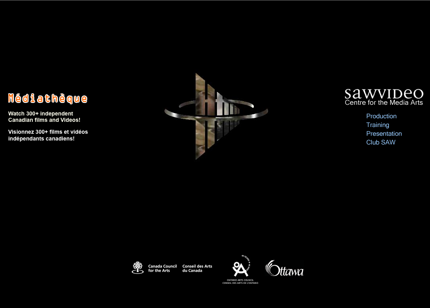Mélanie Hogan: Crashing the Archive: A Research-Creation Intervention into the SAW Video Mediatheque (2012)
Filed under thesis | Tags: · archive, archiving, preservation, storage, video art

“Video Cache is a research creation intervention emerging from my doctoral research into defunct and crashed online archives, in the context of Canadian video art, which has a rich history of self-preservation and of documenting itself as an art movement. From major art galleries to personal collections; Canada has long privileged video as a tool for creative resistance, expression, and experimentation. Video Cache serves to track the SAW Video Mediatheque (based in Ottawa), from its launch to its crash and back online again, by updating its context and addressing in a practical way what it means to ‘activate’ the online archive. Much of my intervention occurred after the crash and during the two years the site was offline. It involved varied methodological entry points including in depth interviews with SAW Video staff and media archaeology to locate digital traces of the site. Key here is Video Cache’s success in simultaneously documenting the project and intervening to address archival loss: while it was the ‘cache’ that made the Mediatheque’s traces visible and re-visit-able, it was the ‘crash’ that signalled its ongoing archival value.” (from Abstract)
PhD thesis
Department of Communication Studies, Concordia University, Montréal, Québec, Canada
April 2012
Markus Krajewski: Paper Machines: About Cards & Catalogs, 1548-1929 (2002/2011)
Filed under book | Tags: · library, media archeology, media history, storage

Today on almost every desk in every office sits a computer. Eighty years ago, desktops were equipped with a nonelectronic data processing machine: a card file. In Paper Machines, Markus Krajewski traces the evolution of this proto-computer of rearrangeable parts (file cards) that became ubiquitous in offices between the world wars.
The story begins with Konrad Gessner, a sixteenth-century Swiss polymath who described a new method of processing data: to cut up a sheet of handwritten notes into slips of paper, with one fact or topic per slip, and arrange as desired. In the late eighteenth century, the card catalog became the librarian’s answer to the threat of information overload. Then, at the turn of the twentieth century, business adopted the technology of the card catalog as a bookkeeping tool. Krajewski explores this conceptual development and casts the card file as a “universal paper machine” that accomplishes the basic operations of Turing’s universal discrete machine: storing, processing, and transferring data. In telling his story, Krajewski takes the reader on a number of illuminating detours, telling us, for example, that the card catalog and the numbered street address emerged at the same time in the same city (Vienna), and that Harvard University’s home-grown cataloging system grew out of a librarian’s laziness; and that Melvil Dewey (originator of the Dewey Decimal System) helped bring about the technology transfer of card files to business.
The book is an extended and updated version of the original ZettelWirtschaft published in German by Kulturverlag Kadmos Berlin, 2002
Translated by Peter Krapp
Publisher MIT Press, 2011
History and Foundations of Information Science series
ISBN 0262015897, 9780262015899
215 pages
review (Tom Wilson, Information Research)
review (Tomáš Dvořák, Teorie vědy, in Czech)
PDF (updated on 2012-9-27)
Comment (0)Matthew G. Kirschenbaum: Mechanisms: New Media and the Forensic Imagination (2008)
Filed under book | Tags: · digital forensics, electronic literature, forensics, hypertext, literature, materiality, storage, textuality, writing

“In Mechanisms, Matthew Kirschenbaum examines new media and electronic writing against the textual and technological primitives that govern writing, inscription, and textual transmission in all media: erasure, variability, repeatability, and survivability. Mechanisms is the first book in its field to devote significant attention to storage—the hard drive in particular—arguing that understanding the affordances of storage devices is essential to understanding new media. Drawing a distinction between ‘forensic materiality’ and ‘formal materiality,’ Kirschenbaum uses applied computer forensics techniques in his study of new media works. Just as the humanities discipline of textual studies examines books as physical objects and traces different variants of texts, computer forensics encourage us to perceive new media in terms of specific versions, platforms, systems, and devices. Kirschenbaum demonstrates these techniques in media-specific readings of three landmark works of new media and electronic literature, all from the formative era of personal computing: the interactive fiction game Mystery House, Michael Joyce’s Afternoon: A Story, and William Gibson’s electronic poem ‘Agrippa.’
Drawing on newly available archival resources for these works, Kirschenbaum uses a hex editor and disk image of Mystery House to conduct a “forensic walkthrough” to explore critical reading strategies linked to technical praxis; examines the multiple versions and revisions of Afternoon in order to address the diachronic dimension of electronic textuality; and documents the volatile publication and transmission history of ‘Agrippa’ as an illustration of the social aspect of transmission and preservation.”
Publisher MIT Press, 2008
ISBN 0262113112, 9780262113113
296 pages
PDF (no OCR; some pages missing; updated on 2014-3-5)
EPUB (added on 2018-7-30)

